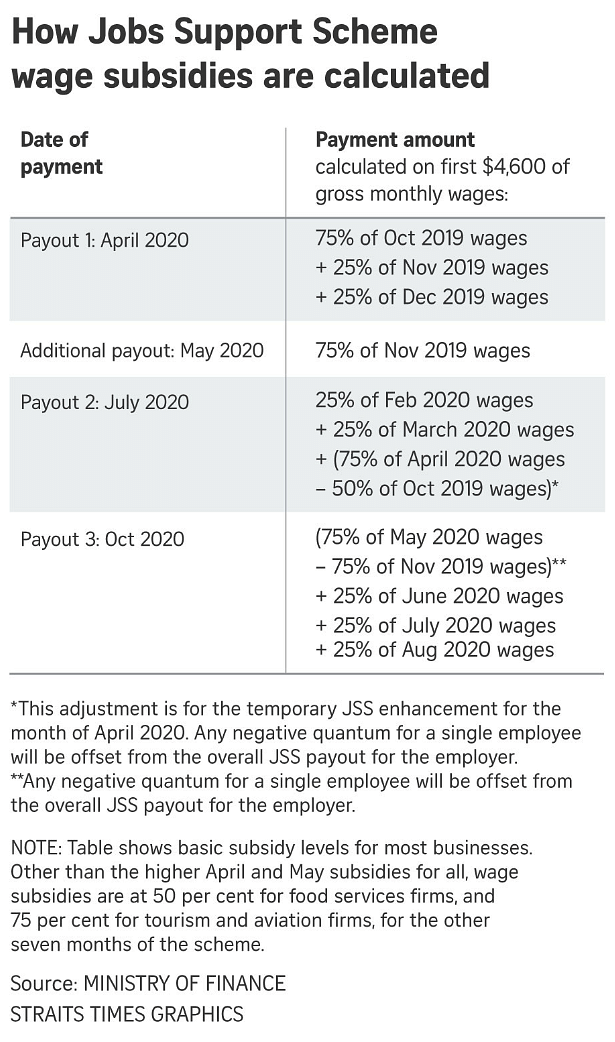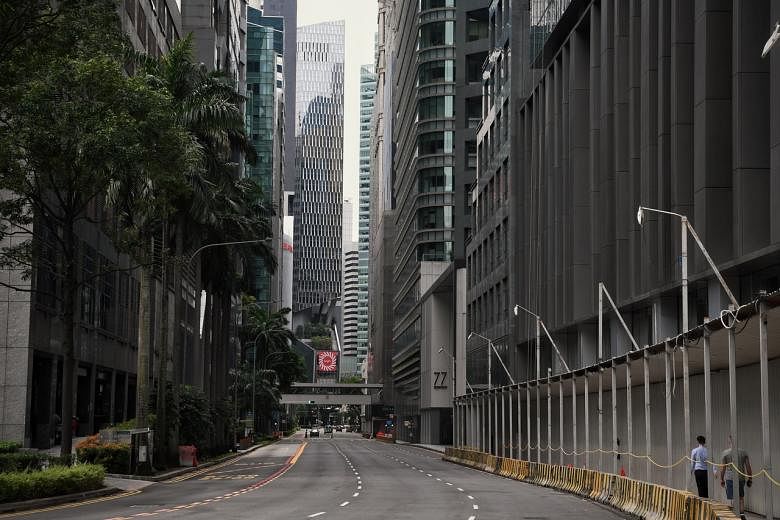SINGAPORE - The latest enhancement to the Jobs Support Scheme will see wage subsidies for all local employees extended to 10 months, up from nine, and more firms receiving higher tiers of support.
Businesses that cannot resume operations immediately after the circuit breaker ends on June 1 will also receive the maximum subsidies of 75 per cent of wages until August or when they are allowed to reopen, whichever comes earlier.
More than 140,000 employers of local workers started receiving the second of four payouts under the scheme from Thursday (May 28).
The scheme pays out 75 per cent of wages for April and May on the first $4,600 of a worker's gross monthly pay, and at least 25 per cent for a further eight months, depending on the sector.
Firms in certain industries such as food services, and marine and offshore will receive 50 per cent of wages for those eight months, while others in sectors like aviation and aerospace, and tourism will get 75 per cent of wages for the full 10 months.
The wage subsidies were first announced in February's Budget and then later enhanced.
Here are seven things to know about the payouts:
1. THERE IS NO NEED TO APPLY
All employers who have made contributions to the Central Provident Fund (CPF) for local staff - Singaporeans and permanent residents - qualify, apart from some on an exclusion list such as local government agencies, embassies or representative offices of foreign companies.
Eligible companies will be notified of the subsidy tier they qualify for and the amount they will receive.
Those with CorpPass access can log in to the myTax Portal to view their notification letters.
Employers using Giro or PayNow Corporate for transactions with the Inland Revenue Authority of Singapore (Iras) will get their payouts faster as they will be credited to their registered bank accounts.Companies not on either scheme will receive payouts by cheque.
2. SUBSEQUENT PAYOUTS WILL BE ADJUSTED DOWN IF EMPLOYERS CUT WAGES NOW
The first payout in April was calculated based on wages paid in October, November and December last year.
The higher support of 75 per cent for April wages is to help firms cope with the circuit breaker measures that have forced non-essential businesses to close their workplaces. It was calculated based on October 2019 wages first so that the money can be paid out faster.
Any difference between a worker's wages in October 2019 and April 2020 will be factored into the second and third payouts.
For example, if a worker was put on no-pay leave in April, the extra payout credited to his employer in the first tranche will be subtracted from subsequent tranches, where possible. If the payout for a single worker cannot cover the extra amount that needs to be subtracted, the amount will be subtracted from the overall payout for all workers under the employer.
The July payout will be based on wages paid in February, March and April this year, while the October payout will be based on wages paid in May, June and July this year.
After the circuit breaker period was extended until June 1, it was announced that the higher wage support of 75 per cent for all businesses had been extended into May, instead of just April.
An additional Jobs Support Scheme payout will be made in May, based on wages paid in November last year. Any difference between a workers' wages in those two months will be factored into the last payout, in October this year.
3. WORKERS EARNING MORE THAN $4,600 ARE STILL COVERED
The subsidy applies to the first $4,600 of gross monthly wages. If a worker earns more than $4,600, his employer gets 75 per cent of $4,600, or $3,450, for April's wages.
Gross monthly wages include employee CPF contributions, but exclude employer CPF contributions.

4. THE PAYOUTS COVER WAGES OF EMPLOYEES ONLY
They do not cover the wages of business owners, such as sole proprietors.
This is because the scheme is meant to help companies retain local staff during the pandemic.
Self-employed people who are eligible for the recently announced Self-Employed Person Income Relief Scheme can receive three quarterly cash payouts of $3,000 in May, July and October this year.
The Jobs Support Scheme also applies to contract workers, not just permanent staff.
Under enhancements to the scheme announced in April, employees who are shareholders and directors of a company will also be covered if they had an assessable income of up to $100,000 last year. They were initially excluded as they were considered business owners.
Thus, the May payout will include back-payment for companies with qualifying shareholder-directors whose wages were excluded in the April payout.
5. THE PAYOUTS GO TO EMPLOYERS, NOT WORKERS THEMSELVES
They are meant to help employers continue to pay local workers' salaries and employer CPF contributions during this period, when revenues have likely been hit.
CPF contribution rates for employers and employees have not been changed.
6. EMPLOYERS CAN CHECK ELIGIBILITY FOR THE HIGHER TIERS OF SUPPORT ONLINE
Originally, only firms in tourism and the aviation sectors would get subsidies of 75 per cent of wages after the circuit breaker. They include airlines, airport ground handlers, travel agents, gated tourist attractions, hotels and operators of meetings, incentives, conferences and exhibitions venues.
Firms in the food services industry, meaning licensed food shops and stalls, including hawker stalls, would receive 50 per cent of wages while other firms receive the base level of 25 per cent.
After the latest enhancement to the scheme, announced by Deputy Prime Minister Heng Swee Keat in his speech on the Fortitude Budget on Tuesday (May 26), firms in the aerospace sector - including those in maintenance, repair and operations - as well as money changers and regional ferry operators, among others, will also receive 75 per cent wage support.
Cinema operators, certain retailers and marine and offshore firms are among those that will get 50 per cent support.
Eligible firms will receive retrospective payouts by July to top up what they have received so far.
Firms in the built environment sector, which includes construction, will receive higher subsidies of 75 per cent for wages paid between June and August, as they are affected by the phased and gradual resumption of activities.
The full list of eligible sectors and firms is available on the Iras website. You can also call 1800-352-4728 during office hours (between 8am to 5pm, on Mondays to Fridays).
There is also an appeal form available on the same website.
7. ENQUIRIES CAN BE MADE TO THE IRAS
You can contact the taxman for more information on the scheme via the online form or 1800-352-4728.












